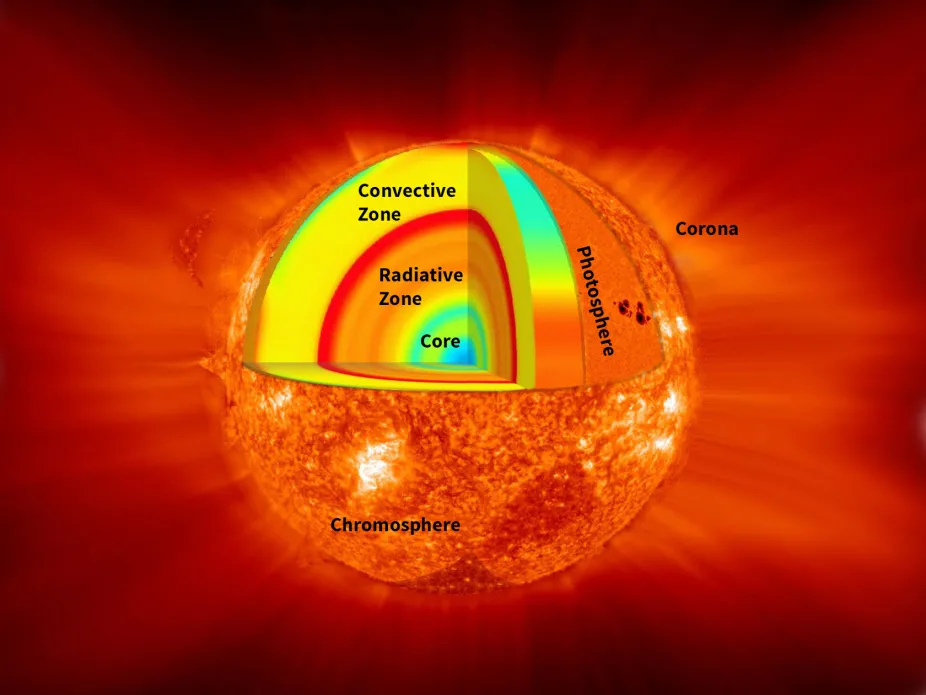Meet the Sun
The Sun is a yellow dwarf star at the center of our solar system. Earth and all other objects in our solar system orbit around the Sun due to gravity – the Sun contains over 98% of all mass in the solar system and so exerts a strong gravitational pull. Like other stars, the Sun is a dense ball of gas that creates energy through nuclear fusion reactions in the core, creating helium atoms from hydrogen atoms. The Sun radiates different forms of energy, including ultraviolet, infrared, and light energy, out into space. Light and heat energy from the Sun warm our planet and make life possible.
This 3D model of the Sun allows you to explore the surface, called the photosphere, up close. Credit: NASA, 2023
Fun Sun Facts
Distance between the Sun and Earth: 93 million miles (149 million km)
Amount of time it takes for light from the Sun to reach Earth: about eight minutes
Diameter: 865,370 miles (1.3927 million km)
Size (compared to Earth): about 109 times wider than the Earth – about 1.3 million Earths could fit inside the Sun
Mass: 1.989 x 1030 kg – about 333,000 times the mass of Earth
Age: about 4.6 billion years old – the same as Earth and other planets that formed within our solar system
Average temperature: varies from 5,600 ℃ (surface) to 15 million ℃ (core)
Amount of light energy the Sun produces each second: 3.8 x 1026 terawatts (one trillion watts) – more than the amount of energy all humans will use in 600 years
Amount of the Sun’s energy that reaches Earth each second: 173,000 terawatts – less than one billionth of the total energy created by the Sun each second
Amount of the Sun’s energy currently used for electricity: less than 0.1%
Length of time for one solar cycle: ~11 years
Length of time to orbit the Milky Way galaxy: 250 million years
What’s the Sun Made of?
The Sun is a glowing, spinning ball of very hot gases, primarily hydrogen (92.1%) and helium (7.9%). Trace amounts of other elements (0.1%), such as oxygen, carbon, nitrogen, silicon, magnesium, neon, iron, and sulfur are also present (NASA).
In the extreme heat of the Sun, most of the gas exists as plasma. Plasma is an electrically charged gas that forms at extremely high temperatures when fast moving atoms collide with each other and knock electrons loose. More matter exists in the plasma state than as a liquid, solid, or gas – the visible universe is thought to be 99% plasma!
The Sun Has Layers

During a solar eclipse (Dec. 14, 2020) the outermost part of the Sun’s atmosphere, called the corona, is visible. The corona sends solar wind made of plasma out in all directions, traveling beyond the boundaries of our solar system.
NASA
Although the Sun isn’t solid, it has three distinguishable regions that solar physicists refer to as the interior, the visible surface, and the atmosphere.
The Sun’s interior is divided further into three parts – core, radiative zone, and convective zone. Inside the Sun, energy is created at the core and moves to the surface through both radiation and convection, similarly to how bubbles move upward in a pot of boiling water on your stove.
The boundary between the Sun's interior and the solar atmosphere is called the photosphere. It is what we see as the visible surface of the Sun. The photosphere is not like the surface of a planet; even if you could tolerate the heat, you couldn't stand on it.
The Sun does in fact have an atmosphere! The Sun’s outer atmosphere (also called the corona) is the source of solar wind, which extends millions of kilometers into space, beyond the orbits of Earth and the other planets. Solar wind is, in a sense, just an extension of the Sun’s atmosphere. Our planet actually orbits within the atmosphere of a star! The Sun’s lower atmosphere is called the chromosphere because the high hydrogen content causes it to appear red when viewed through a solar telescope.

The interior layer of the Sun includes the core, radiative zone, and convective zone. The photosphere is the surface layer of the Sun, and the solar atmosphere includes the chromosphere and corona.
SOHO (ESA & NASA)
The Sun Emits Light and Other Forms of Energy
The Sun continuously emits vast quantities of energy as light and other forms of electromagnetic radiation. It also gives off large amounts of matter as particle radiation called solar wind, mostly in the form of high-energy protons and electrons.
The amount of light emitted by the Sun is relatively constant, varying by less than 0.01% over each decade. However, because the Sun radiates such a large amount of energy (3.8 x 1026 terawatts per second), even small fluctuations can have an impact on Earth. Explosive solar storms sometimes crash into Earth, interfering with human communications, navigation, and electrical transmission technologies. The energy from these solar storms also interacts with the upper layers of Earth’s atmosphere to create the beautiful displays of color we call the aurora or northern and southern lights.
How Does the Sun Make Energy?
The Sun’s energy is generated by nuclear fusion occurring in its core. Here, protons of hydrogen atoms violently collide and fuse to create helium atoms. The nuclear fusion process produces energy in the form of gamma rays, which are transformed into thermal energy, warming up the Sun’s core to around 15 million degrees Celsius. Through a process that takes tens of thousands of years, thermal energy moves from the Sun’s core to its outer layers. Once the thermal energy reaches the Sun’s surface, it is released into space as electromagnetic radiation.